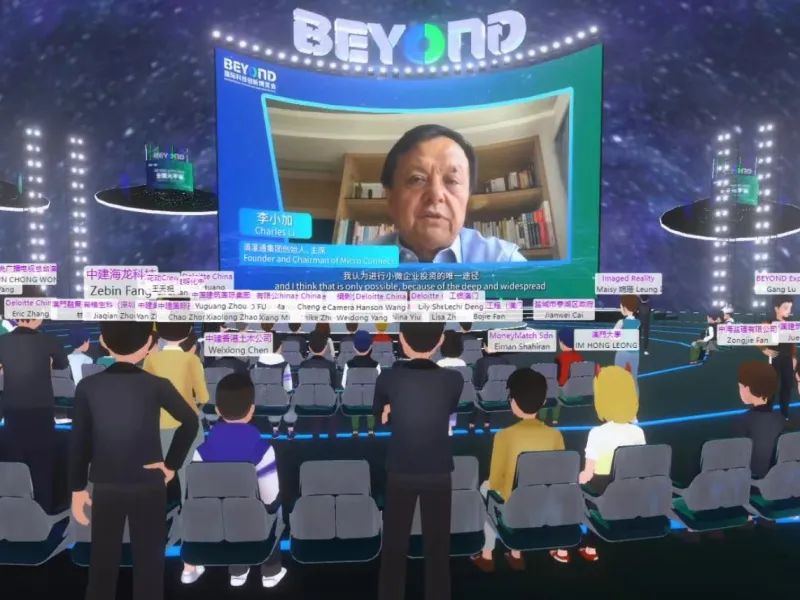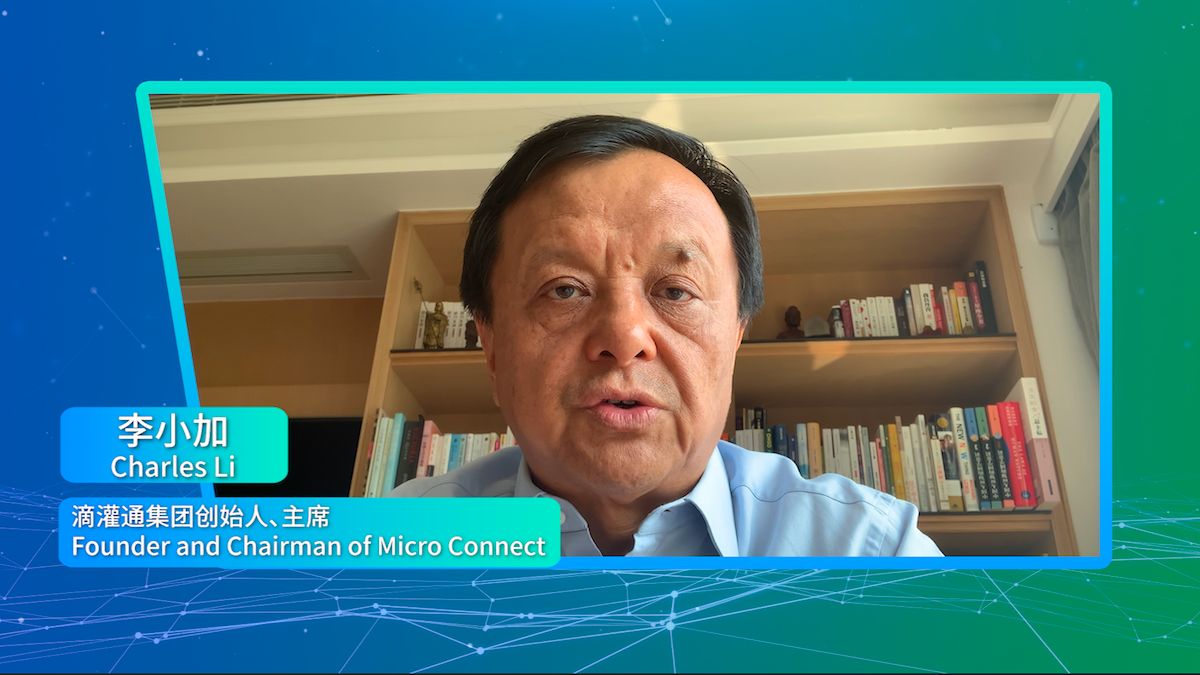
Charles Li, former Chief Executive of the Hong Kong Exchanges and founder of Micro Connect, spoke at the BEYOND Expo 2022 about how he sees a wave of disruption on the horizon for traditional financial services in the Internet era. He also explained how Micro Connect is set to ride that wave, helping global capital access China’s small business sector in the hopes of gaining sustained growth, opportunity, and quality.
The BEYOND Expo 2022 opened online in the BEYOND Metaverse on Wednesday. As Asia’s largest and most influential tech event, the Expo will have more than 40 talks and panel discussions where leaders and experts across sectors dive deep into the topics of consumer tech, health tech, global investments, sustainability, and Web3.

Please find below the transcript of the opening day speech from Charles Li, Chairman and founder of Micro Connect. The following transcript has been edited for clarity:
Hello, everybody, my name is Charles Li. I’m Chairman and Founder of Micro Connect. I’m really very pleased to be able to speak at the BEYOND International Technology Innovation Expo in Macau, and on the subject of what’s next, I’ll be very happy to share some of the experiences and insight that we have developed over the last couple of years since I left the Hong Kong exchanges.
I have been in finance for more than 25 years now, including 11 years running the Hong Kong stock exchange. And I think that experience gave me tremendous insight as to how the financial system works in our economy and in our society.
I think that the modern Wall Street model, which has worked wonderfully for over 100 years now, is probably one of the most important human innovations in our society because we try to organize capital into big corporations and then divide them up into stocks and shares so that they can be held by the public.
On the one hand, you concentrate finances so that centralized markets are able to allocate them to important, large corporations to develop the economy. On the other hand, the shareholding system allows that capital to be distributed and held by the general public. That model works for the industrial age, because the economy at the grassroots level is unclear, and very difficult to gather information from, so you need a centralized, institutionalized, professionally staffed Wall Street to organize everything together so that information can be discovered, price can be discovered, and execution can be delivered in the traditional financial market sort of systems.
But I think what’s next is the most interesting question: whether or not what we have seen happening in e-commerce, in social media, whether the revolutionary changes and disruptions that we have witnessed over the last two decades could potentially similarly disrupt the traditional Wall Street model.
I think we all know that in the Industrial Age, we all needed to go to a department store, because the department store aggregated all the goods and merchandise together, so that we all went to the central market to buy what we needed. But in the Digital Age, the Internet Age allows that distribution and commerce to be conducted online via digital technologies, and then allows logistics to be developed so that we are able to actually shop at home and have our goods delivered, and have marketplaces, online marketplaces, to allow money and goods to be exchanged. That’s a fundamental disruption of traditional finance and traditional commerce.
And I believe that we are now coming to the age where similar disruption is going to happen to financial services as well. Because at least in China today, the entire economy has largely become cashless. What that means is that most of the financial activities in China, even at the smallest business level, are completely digital, which means that they’re completely transparent. With the digitalization of the businesses at the grassroots level transparent and digital, the question becomes do we still need to force the little guys to organize into big corporations?
And many of them never will. Millions of them never will.
China has 17 million small businesses, and I think it is time now for us to actually have the opportunity to completely change the face and change the structure of financial services, to allow finance for the first time to be actually connected as sustainable capital to provide growth, and a firm growth and CapEx and development at a small businesses level.
And more importantly, that allows the global investment community to be able to finally access the longest sustained growth opportunity and quality returns from a blue ocean of small businesses that have not yet currently been available because of the concentrated nature of our financial services. So at Micro Connect, we’re trying to innovate a complete new way of delivering financial services.
Instead of using the traditional product, the traditional discovery processes, and the traditional delivery processes, we actually adopted a completely new way of doing it. It’s what we call a new operating system, a micro star, and has five key elements. It’s a new product. There are two arms, and there are two maps. That really is the new micro star operating system to do finance differently.
First of all, why did we want to focus on small businesses? It is very clear, small businesses largely reside in the consumer sector. And that entire sector and the small businesses contribute to close to 60% of China’s GDP, 70% of government revenues, and close to 80% of employment. So it is clearly the sector where the most vibrant part of China’s economy currently exists and grows, and capital needs to find a way to access that tremendously important sector.
And we set up our mission to achieve that. The way to do so is, as I said, a new system that we call micro star, which consists of five key elements: one product, two arms, and two maps. The one product is called a daily revenue contract, DRC. This is not debt, because as investors we have to share the downside.
And it’s not equity, because equity is not economically feasible for us to execute the small levels on a large scale. But it is a daily direct contractual arrangement to pay back your revenue, in exchange for an upfront CapEx investment. So it’s called a daily revenue contract, DRC.
It’s a completely new asset class that is fit for purpose, and very helpful to small businesses. Meanwhile, the daily recovery of returns allows the investors to take transparent, distributed, reliable, risk-managed and diversified high-quality returns.
So it’s really a win-win for all, kind of a new product.
But that product’s unique nature requires two very different systems of ensuring delivery, and on that distributed level we have to be able to collect on the investment.
So there are two arms, one arm is in charge of collecting money digitally, directly from the revenue from the little businesses. And that sort of a digital account split system in the various consolidated payment systems in China is highly advanced and highly feasible and is actually being practiced by many industries, so we just intend to utilize the existing technology and systems to allow our investors to be able to secure the daily digital connection of returns.
On the other hand, when the money is collected, we want to make sure that we have a modern new kind of exchange, where the underlying infrastructure is a blockchain, allowing us to authenticate that every single dollar that is collected every day into the system is irrevocably recorded in the blockchain, and belongs to the investors who choose to invest in any particular segment, in any particular store, for any particular period.
So that ultimate penetrated regulatory oversight, through technology, is the way that we are able to do this on scale, with efficiency, with very minimal human and costly management and delivery, monitoring, and enforcement systems, which would not be feasible economically for the small businesses.
The newest micro star system also has two what we call maps, basically navigation. And those two maps are specialized terms, essentially describing an engine that allows us to deploy such huge numbers of a small investment individual size on a large scale with efficiency; the other map is allowing us to find ways to make sure that we are able to accurately project economic and financial performances of particular kinds of businesses and particular locations so that investments can be rolled out not only with scale and efficiency, but with accuracy and quality, so that the investment can continue on a sustainable basis.
This new way of doing things has never been tried before but because of the digitalization of China, it is highly feasible.
We have started the journey, we have invested in over 1,000 stores in China across over 100 different sectors, largely focused on the four large industries: retail, consumer, services, and cultural activities. Those are the sectors where it’s the basic needs of everyday life of the Chinese consumers, despite all the challenges and despite all the perceptions that small businesses in China are risky individually and may not necessarily be investable.
As a whole, if we’re able to build a portfolio large enough, diversified enough, distributed enough, we will truly be able to find a new way of investing, a new paradigm of financial services, that is transparent, distributed, diversified, and sustainable. Most importantly, because the fact that we are able to do so in such a distributed manner – impacting potentially hundreds of thousands, and potentially millions of small businesses – our aspiration is that in the next 10 years, we are able to create and fund a million small businesses with a million annual revenues, which in turn will be able to create and maintain at least 10 million jobs.
This sort of an investment, new investment paradigm, will likely allow us to promote impact investing, ESG mapping, so that through investing, we’re not only doing good, we can also do well.
And that is really, is our dream and that is something that we’re now on the journey to achieve, and I think that is only possible because of the deep and widespread digitalization and technology evolution in China particularly in the payment industry. I think with that, we can see that China’s consumer sector, which may be the furthest away from Wall Street in the traditional financial services methodologies, thanks to technology, probably will become the closest and most likely going to become the most successful, because they are able to give us a way to invest simply, more efficiently, more equitably, and more inclusively.
And I hope that we will be back again to update you on our progress, and I hope that we will be able to travel on that journey together with many of you who have similar dreams and aspirations.
Thank you very much, we really appreciate the opportunity to speak at this great expo.